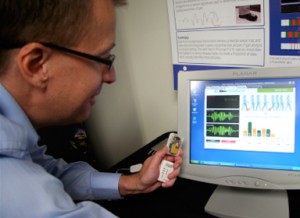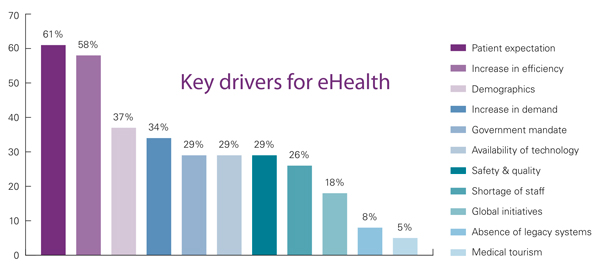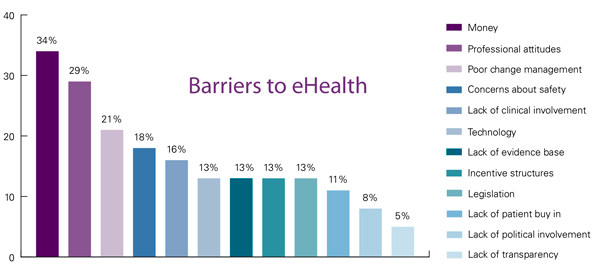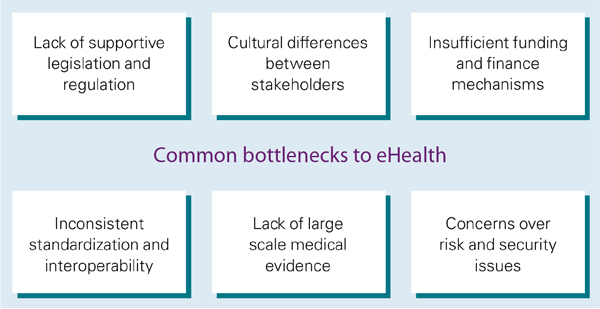An overview of findings from research gathered from 39 health leaders from across 15 countries and three different regions – Europe, ASPAC and the Americas – in the field of health management, health policy and eHealth
by Mark Britnell and Jan de Boer, KPMG
 The case for eHealth has never been more compelling yet its performance globally has never been more mixed. Research, which covers many executives working across many different countries, points to successful examples of both the conceptualization and execution of value adding eHealth initiatives. For too long, eHealth strategies have focused on ‘pushing’ people to accept, often as an article of faith, promised high level benefits which do not fully materialize.
The case for eHealth has never been more compelling yet its performance globally has never been more mixed. Research, which covers many executives working across many different countries, points to successful examples of both the conceptualization and execution of value adding eHealth initiatives. For too long, eHealth strategies have focused on ‘pushing’ people to accept, often as an article of faith, promised high level benefits which do not fully materialize.
Rather, inspiration might be taken from successful ‘pull’ movements which attract and harness the power of the crowd. The explosion of social networking is perhaps the greatest example of how individuals are ‘pulled’ together to rejoice in the power of the crowd. Today’s ‘crowd’ is tomorrow’s patients. Increasingly therefore, ‘tech-savvy’ clinicians need to be seen not as a block to be ‘won over’ but as a catalyst to be nurtured and supported. This approach will deliver sustainable success and avoid costly failures. Before we address the health industry specifically, let us, for just a moment, pause and think about e-trends in our wider society because they offer valuable insights for the possibilities in healthcare. While, as consumers, we may struggle to comprehend the gigabyte and terrabyte, we now have to be prepared for new binary prefixes – peta, exa and zetta which respectively denote 1 million, 1 billion and 1 trillion gigabytes.
Exploding data
The amount of digital data is exploding, up by 30 percent in just one year with an estimated 1.8 zettabytes in use in 2011. Technically there is no limit in the amount of data that we can store in different systems and in the cloud. At the moment the ‘T’ in Information Technology (IT) is pretty much solved. The real challenge for the future of healthcare is how do we get a grip on the ‘I’. In other words, how do we extract reliable information out of all the data that will be available?
In 2012, we can expect the possible initial public offering (IPO) of Facebook with its 800 million users while Twitter will host 500 million ‘tweets’ per day. This awesome force and the power of the crowd can be used to push eHealth into new areas of support and care. eHealth will no longer be seen as an IT solution in the same way the Internet is no longer seen as an IT solution. eHealth will become mainstream, part of our daily lives and ultimately synonymous with health. Few would argue over the power technology will have to help solve the many challenges now facing healthcare.
 Yet, around the world, there has been a largely inconsistent approach to eHealth. Many jurisdictions are either developing or implementing large scale change programs, the likes of which have not been seen in healthcare for the last hundred years. While some projects have ultimately been successful, more often they have lost momentum after the pilot phase, collapsed under their own complexity, or become irredeemable thanks to spiraling implementation costs. Recently both the Netherlands and the UK have scaled back their eHealth initiatives, reflecting the significant challenges faced by some of the larger, government-led programs.
Yet, around the world, there has been a largely inconsistent approach to eHealth. Many jurisdictions are either developing or implementing large scale change programs, the likes of which have not been seen in healthcare for the last hundred years. While some projects have ultimately been successful, more often they have lost momentum after the pilot phase, collapsed under their own complexity, or become irredeemable thanks to spiraling implementation costs. Recently both the Netherlands and the UK have scaled back their eHealth initiatives, reflecting the significant challenges faced by some of the larger, government-led programs.
Based on KPMG’s global experience and interviews with 39 eHealth leaders, planners, experts and implementers around the world, three concepts have been developed that – in our experience – can help eHealth participants to develop and implement a holistic and integrated approach.
This change can be facilitated with three basic concepts:
- Crowd accelerated innovation suggests that eHealth becomes more sustainable based on the size of the program and breadth of stakeholder adoption. Participants will need to share a clear vision, strive for full transparency in processes and objectives, and use the power of the crowd – of bringing doctors and patients together – to create an economy of scale to cut costs and bolster innovation.
- Collaborative alignment recognizes the importance each player has in the healthcare continuum and places a high value on their active participation in the development and operation of the system. Aligning the interests and efforts of stakeholders is key to the success of eHealth, and to enabling its lasting presence in healthcare organizations.
- Creative dislocation, thanks to eHealth’s transformative nature, is essential. The introduction of new methods will make many legacy processes and approaches redundant. Stakeholders must be prepared to change the way they work, rather than just seeing eHealth as an ‘add-on’. This is one the best way to integrate eHealth into the fabric of the healthcare environment.
Sustainability
How will eHealth programs move beyond the pilot stage through implementation to a state of sustainability? The truth is that there is no single global path to eHealth transformation. Each jurisdiction will need to face the specific challenges and complexities in their own markets to find a unique path to success.
A good example of these concepts can be found in the Hong Kong Health Authority. In this ‘tech-savvy’ Chinese Special Administrative Region (SAR) clinicians, facilitated by executives, have developed a high value, relatively low cost eHealth tool which provides personalized, preventative and purposeful care for patients. The system, known as HARRPE (hospital admission and risk reduction program for the elderly) provides algorithm based data extraction of 44 key sentinel social and medical markers to analyze – every night – patients that might be vulnerable to re-admission. Nurse-led outbound and inbound care, advice and support reduced re-admissions by 25 percent. More remarkably, this system, which is gradually being extended across all7 million citizens in Hong Kong, takes an average of two, twelve minute calls from a nurse practitioner: 24 minutes to reduce admissions by 25 percent.
This successful example also reinforces the three key basic requirements that were repeated time and time again by our respondents. While separately these requirements are patently obvious, it is still surprising to see that they are not always managed together.
Create a strategic plan that provides clarity, vision and a consistent approach to eHealth. Without a shared vision and consistent policy on eHealth, governments and system managers will find it increasingly difficult to achieve value for their investment or better clinical outcomes for patients. This doesn’t necessarily mean mandating a system-wide approach, but it does require everyone to be heading in the same direction.
Focus on core elements that drive the greatest benefits for the largest number of people. eHealth initiatives are massive projects and simply can’t be done in one step. Some of the more successful systems are the ones that start by focusing on the most common elements of the healthcare process (such as discharge letters, diagnostic tests and prescription records) and then incrementally add components once the core system has been developed and adopted.
Change processes
Healthcare professionals and patients in the lead. The level of change around processes, eHealth and empowered patients can be daunting to healthcare professionals. But by ensuring that clinical staff own and drive eHealth program development, and then demonstrating the program’s benefit through evidence based clinical outcomes, health system managers are able to drive adoption and become significant evangelists.
But across this spectrum of successes and failures, there are a number of key lessons to be learned by eHealth pioneers which will help refine strategies throughout the industry and narrow the focus of eHealth programs. Indeed, for eHealth to deliver on its promises it must not only be implemented – it must also be sustained. This means evolving eHealth from a lab-bench innovation in healthcare into a full scale and sustainable model that ultimately leverages the power of the crowd and transforms the whole industry.
We would like to thank our healthcare clients, Manchester Business School (MBS) and all those who participated in this work and hope that the report makes a contribution to the development of eHealth.
The case for eHealth
There is little doubt among healthcare professionals, governments and system managers that eHealth has the potential to redefine the healthcare industry. Indeed, the combination of mobile devices, cloud computing and networking capability presents a great opportunity to promote eHealth.
The potential benefits of eHealth are not disputed. Freed from the burden of paper files, advocates envision a world where patients are empowered with access to their own records where healthcare facilities are interconnected, sharing everything from patient records and diagnostic images to operating room bookings and accounting platforms.
The resulting system would not only be patient-centric in its approach. It would also deliver a cost-effective way of building the capacity of health systems, both in the developed and developing worlds. In some cases, this metamorphosis could not come too soon.
Facing an era of greater financial austerity and rising healthcare costs, many governments and health systems are now taking a closer look at eHealth as a sustainable way to deliver cost savings, better patient outcomes and greater accessibility of healthcare for all.
There is certainly anecdotal evidence that patients are ready for eHealth’s benefits. Beyond the ultra-tech-savvy early adopters, many baby boomers are also technologically adept and, as they retire and come into greater contact with the health and social care systems, they are increasingly taking a greater role in their own healthcare decisions. These consumers already bank and book holidays online, and are starting to ask why they can’t book a doctor’s appointments and review health information in the same way.
Already we are seeing patients take greater control of their medical information and data. PatientsLikeMe.com, a patient-driven health site that leverages social media approaches to connect patients suffering from similar conditions, already has more than 120,000 members. But with greater patient empowerment in controlling their data will come additional responsibilities. Patients will need to support the accessibility of their data and permit the transfer of their personal health information throughout the patient pathway if they are to enjoy the full benefits of eHealth.
There are a number of common bottlenecks to eHealth (see Table 1) and – from the outset – eHealth promoters and advocates will need to manage expectations, since long, complex change programs tend to lose momentum as time passes. Moreover, some eHealth objectives – particularly a significant improvement in patient health – may take years to achieve, making it all the more important that funders, patients and healthcare professionals share the same long-term vision. And while demand from healthcare professionals may build slowly, the profession is recognizing the potential clinical benefits of having the whole patient record at their fingertips. As a new generation of medical professionals gains seniority in healthcare practices, demand and acceptance will sharply increase. Around the world, we have seen plenty of pilot programs, but often there is a lack of clear vision on how to properly adopt eHealth in the clinical setting; an issue that urgently needs addressing. Indeed, in our experience, healthcare professionals start to become voracious users of eHealth systems as they begin to see the clinical and efficiency benefits that a well-designed system can deliver.
Universal delivery
Implementing eHealth programs and sustaining them are very different ventures. Sustaining eHealth requires programs to move beyond the pilot stage in such a way that promised benefits are consistently and universally delivered. To become sustainable – indeed, to become the new standard of healthcare delivery – radical change will be required in every aspect of the healthcare system.
eHealth must move from being simply an innovation in healthcare through a sustainable change process to ultimately transform healthcare delivery. The simple truth is that, until eHealth becomes the status quo rather than the outlier, governments and funders will not see the full value of the transformation. Through this research and our extensive experience in the field, we have developed three concepts that, when used as lenses through which to view planning, may well help achieve sustainability.
For eHealth programs to become sustainable, they must reach critical mass. Collaborative alignment Sustaining the eHealth transformation requires everyone in the health system to work together to achieve results. There is one certainty of eHealth: things are going to change. eHealth planners must recognize that change is inevitable and be willing to engage in creative dislocation to eliminate outdated concepts and tools.
Ultimately, there will be as many different models of eHealth as there are healthcare systems, and each will take a unique approach to both implementation and long-term sustainability.
But, to move from being simply an innovation in healthcare through to being a sustainable change process to transform healthcare delivery, we believe eHealth planners will benefit from considering their initiatives against three fundamental concepts: crowd accelerated innovation, collaborative alignment and creative dislocation. The research also shows that, almost regardless of the underlying market characteristics, building a successful and efficient eHealth system comes down to the strength of strategic planning, the communication of a clear vision and the ability to harness professionals. So while there is no single path to eHealth transformation, we firmly believe that eHealth is too important, and too expensive, for implementing organizations to repeat the mistakes of their peers. Indeed, much value will come from sharing lessons and best practices between countries, systems, institutions and professionals.



